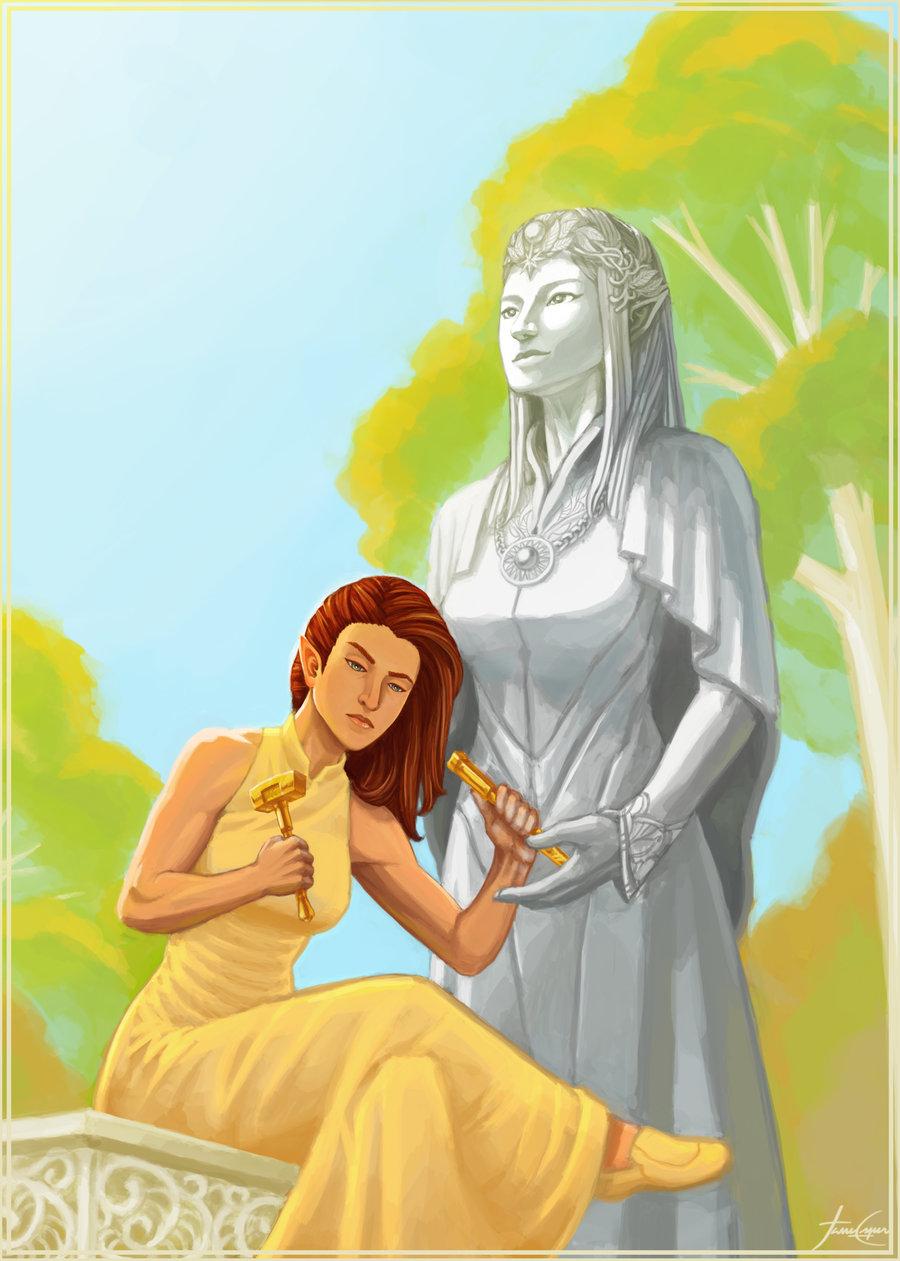Elves
> Nerdanel
Nerdanel
In The Silmarillion, Nerdanel
the Wise was the daughter of the great Noldorin smith, Mahtan, who studied under the Vala, Aulë as a favored student. She married Fëanor in his youth, before he
became king of the Noldor after Finwë's death. She was the mother of Fëanor's seven sons1, all princes of the Noldor: Maedhros, Maglor, Celegorm, Curufin,
Caranthir, Amrod, and Amras.2
Nerdanel "was firm of will, but more patient than Fëanor, desiring to understand minds rather than master them". Some of her mood went to some of her sons, but not to all. She was the only one to whom Fëanor would listen, who could restrain him "when the fire of his heart grew too hot". 1
Fëanor's later deeds grieved her and they
became estranged1; she refused to join Fëanor's revolt. The Peoples of Middle-earth gives more detail, including that Nerdanel became estranged from Fëanor
after he became more violent and rebelled against the Valar. She then
stayed with her father, and listened to the counsel of Aulë
warning that Feanor and all his children would die if they went. When
Fëanor started to head out of Valinor, she asked that he leave her the
two youngest children, but he refused, saying she could have them all
by coming with them. She warned him that one of the children would not
arrive in Middle-earth with him. When he burned the boats, it was
partly to prevent the return of any of his sons, but then he discovered
that one of the two young twins had been sleeping in one of the boats;
that was the one Nerdanel had foretold would be doomed when she was
giving them the mother-names. All of the children except Curufin
preferred using their mother-names.8 In what was the the
latest version, and which does not contradict the previous, when Feanor
was about to go, Nerdanel requested leave to abide with Indis.4, 7
In appearance, Nerdanel had the rare,
red-brown hair of her kin. Her son, Maedhros, had this hair and was
sometimes called by his brothers and other kin, Russandol, meaning "copper-top, mentioned in The Shaping of Middle-earth".3 This red-brown hair is referred to again in The Peoples of Middle-earth, where Maedhros and the two youngest who were twins, were red-haired, although the elder twin's became darker over time.8
Mahtan is referred in the same book as having brown hair with
coppery-red glints, and that Maedhros and the twins had it,with
Maedhros adding the wearing of a copper circlet. It also mentions that
twins were rare among the Noldor. 9, 10
Nerdanel was not the fairest of her people, so Fëanor
surprised others by choosing her. She was strong, free of mind,
desirous of knowledge, and enjoyed wandering in exploration; it was on
one of those wanderings that the two met. She learned a great deal from
her father, Mahtan, of crafts rarely known to women of the Noldor. She
could make things of metal and stone, including astonishingly life-like
images of the Valar and Eldar so that a person not knowing better might
speak to one. She also made beautiful images that were strong and
abstract. Nerdanel would often listen to people while closely watching
their expressions and gestures. The histories show no other elven woman
having so many children.5
The original name of Nerdanel was Istarnië, later dropped.6
References:
The Silmarillion: paperback, first Ballantine Books edition, 1979.
1. "Of Fëanor"
p. 69, 71
2. "The Flight of the Noldor" p. 93
Histories of Middle-earth 4: The Shaping of Middle-earth: paperback, Del Rey, first Ballantine Books edition, 1995.
3. "The Quenta" p. 260
Histories of Middle-earth 10: Morgoth's Ring: hardback, Houghton Mifflin Co., 1993.
4. "The Later Quenta Silmarillion" p. 253.
5. "The Later Quenta Silmarillion" p. 272-3. Large section on Nerdanel.
6. "The Later Quenta Silmarillion" p. 273 Istarnië name.
7. "The Later Quenta Silmarillion" p. 279
Histories of Middle-earth 12: The Peoples of Middle-earth: hardback, Houghton Mifflin Co., 1996.
8. "The Shibboleth of Fëanor" p. 353-5
9. "The Shibboleth of Fëanor" p. 365-6
10. "The Problem of Ros" p. 368
top
